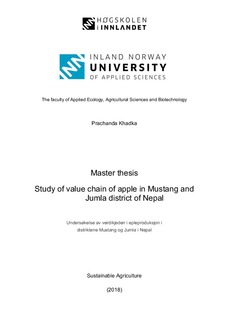Study of value chain of apple in Mustang and Jumla district of Nepal
Master thesis

Åpne
Permanent lenke
http://hdl.handle.net/11250/2626065Utgivelsesdato
2018Metadata
Vis full innførselSammendrag
A study was conducted on the value chain of apple in two apple producing mountainous
districts of Nepal: Mustang and Jumla. The study focused on increasing the access of rural
farmers to the market by identifying the actors of the value chain and the problems and
prospects associated with apple production and marketing.
The survey with 30 apple producers in each district along with the survey of the market actors
was done in December 2017 and January 2018 with a semi-structured questionnaire. The
contribution of apple production in the household economy was found to be 68.27 % in
Mustang district and 44.8% in Jumla district. The cost of production of apple per kg was found
to be Rs 47.24 and 19.53 per kg in Mustang and Jumla respectively. Labour cost was found to
be the highest factor for the cost of production of apple in both the districts with a total share
of 68% and 64% in Mustang and Jumla respectively. The other factors of cost of apple
production analyzed were cost of fertilizer, plant protection and farm equipment.
Economic analysis revealed that the benefit cost ratio for production of apple in Mustang and
Jumla were 1.98 and 2.44 respectively. Marketing margin was Rs 95.33 per kg in Mustang
and Rs 107 per kg in Jumla district. Similarly, producer’s share was 47.03% in Mustang
whereas only 28.67% in Jumla.
The major problem for production of apple in both the districts was found to be the disease
and pest infestation requiring a good consideration from the concerned authorities. The study
was concluded with identifying the apple production as a viable option to the farmers from the
rural high lands of Nepal with a need of further development in the marketing system of apple. En studie er gjennomført for å undersøkelse verdikjeden i epleproduksjon i distriktene
Mustang og Jumla i Nepal. Studien har fokusert på å øke arealet til lokale bønder ved å
identifisere aktører i verdikjeden i epleproduksjon, og se på utfordringer ved produksjon og
markedsføring av produktene.
En spørreundersøkelse hos 30 epleprodusenter i hvert av distriktene ble gjort i desember 2017
og januar 2018, ved hjelp av et strukturert spørreskjema. Bidraget av epleproduksjon i den
totale økonomien hos produsentene ble funnet til 68,27% i distriktet Mustang, og 44,8% i
området Jumla. Produksjonskostnaden pr. kilo produserte epler ble funnet til å være Rs 47,24
og Rs 19,53 i henholdsvis Mustang- og Jumla-området. Arbeidskostnaden ble funnet til å være
den høyeste kostnadsfaktoren ved produksjon av epler i begge distriktene, med 68% i Mustang
og 64% i Jumla. Andre kostnadsfaktorer ved epleproduksjonen vist i analysen var knyttet til
gjødsel, plantevernmidler og maskiner.
En økonomisk analyse viste at forholdet mellom inntekt og kostnad ved produksjon av epler
var på 1,98 og 2,44 for henholdsvis Mustang og Jumla. Marginen ved salg var på Rs 95,33 pr.
kg i Mustangdistriktet, og Rs 107 pr. kg i Jumladistriktet. Samtidig var produsentens andel på
47,03% i Mustang og kun 28,67% i Jumla.
Et stort problem ved produksjon av epler i begge distriktene var knyttet til sykdommer og
smitte, som også er noe myndighetene er opptatt av. Studien konkluderte med at
epleproduksjon er en mulighet for mange gårdbrukere i Nepal, der det er et behov for å øke
produksjonen, samtidig som markedstilgangen på epler må bedres.